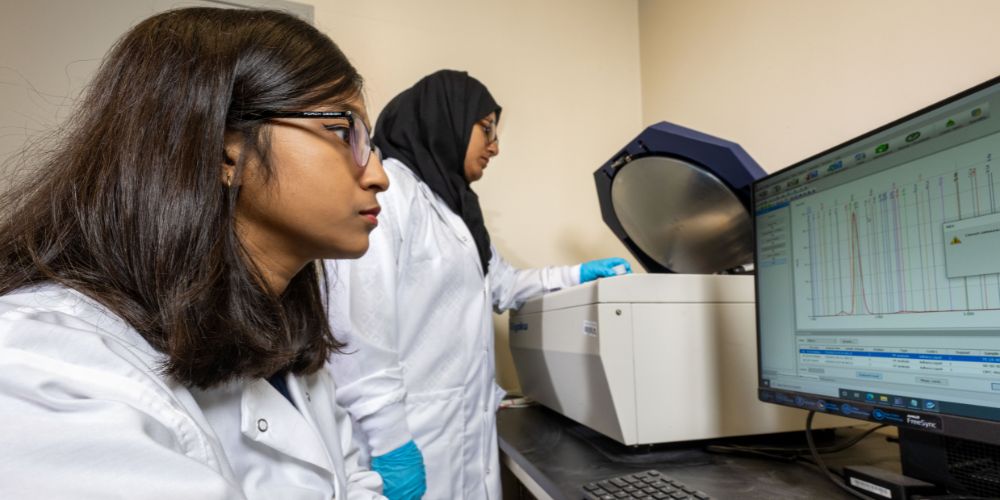New research shows urine tests may detect early diseases
Wednesday, Oct 23, 2024 • Katherine Egan Bennett : contact

Early detection is critical when it comes to curing diseases like cancer, but not everyone has easy access to screening tools. For problems in the genitourinary (GU) tract (which includes the kidneys, prostate, and bladder), health providers usually use a combination of screening tools, including blood tests, imaging, and physical examinations. Scientists are now working on an even simpler tool for screening illnesses before they become a problem – urine analysis.
According to a new study from scientists at The University of Texas at Arlington, Chan-Zuckerberg Biohub, and Stanford University, studying the RNA (a type of genetic material) and other substances within urine can show changes in cell types, revealing early signs of cancer and other diseases. This method could help clinicians detect problems earlier when they are more easily treated without invasive procedures.
“The current gold standard for detecting many GU ailments is a biopsy where small tissue is removed during a rectal exam and sent to the lab for analysis. The invasive nature of the test can scare some people from getting the care they need,” said Joseph Buonomo, assistant professor of chemistry at UTA and an author of the study. “Our preliminary research shows that studying the RNA found in urine can detect some ailments in their earliest stages where they are easily—and cost effectively—managed.”
In the study, the team collected urine samples from two groups of people – healthy individuals and people with kidney stones. Researchers took two types of RNA from the urine – cell-free RNA that floats freely in urine, and sediment RNA, which comes from solid particles. The types of RNA were then sequenced and analyzed, comparing the specimens from the healthy individuals to the ones with kidney stones. They found that advanced urine analyses identified patterns in cells indicative of whether a person has disease.
“We’re excited about this new research as it may lead to new, easier screening tools that can help detect diseases of the bladder, kidneys, and prostate,” said Buonomo. “Although our patient cohort was small, it lays the groundwork for development of a type of ‘non-invasive liquid biopsy’ that will be used to track the progression of ailments like kidney stones, diabetes, and cancer using urine instead of surgical specimens.”
The next phase of the research, Buonomo said, is working on advanced machine learning techniques to further fine-tune the types of differences that can be detected when comparing the RNA and protein signatures of healthy individuals to individuals with diagnosed diseases. They hope identifying additional biomarkers will pave the way for simpler, less invasive diagnostic procedures in the future.
***
This work was supported by grants from Chan Zuckerberg Biohub, Department of Veterans Affairs, Howard Hughes Medical Institute, National Cancer Institute, National Institutes of Health, National Science Foundation, and Stanford University.

Located in the heart of the Dallas-Fort Worth Metroplex, The University of Texas at Arlington is a comprehensive teaching, research, and public service institution dedicated to the advancement of knowledge through scholarship and creative work. With an enrollment of approximately 41,000 students, UT Arlington is the second-largest institution in the UT System. UTA’s combination of outstanding academics and innovative research contributes to its designation as a Carnegie R-1 “Very High Research Activity” institution, a significant milestone of excellence. The University is designated as a Hispanic Serving-Institution and an Asian American Native American Pacific Islander-Serving Institution by the U.S. Department of Education and has earned the Seal of Excelencia for its commitment to accelerating Latino student success. The University ranks as the No. 1 national public university in the U.S. for veterans (Military Times, 2024), No. 4 in Texas for advancing social mobility (U.S. News & World Report, 2025), and No. 6 in the United States for its undergraduate ethnic diversity (U.S. News & World Report, 2025). UT Arlington’s approximately 270,000 alumni occupy leadership positions at many of the 21 Fortune 500 companies headquartered in North Texas and contribute to the University’s $28.8 billion annual economic impact on Texas.
Latest News
- School social workers an underutilized resourceAs mental health challenges in children increase, schools struggle to best deploy social workers into the field
- UTA recognized for innovation and economic prosperityDesignation from APLU recognizes University’s economic development leadership
- Maverick entrepreneurs hope to make AI use betterPluto Learning allows students to use AI ethically for academic success
- UTA to offer STEM-focused MBA in springThe new MBA will focus on emerging technologies in business
- New UTA program boosts students’ career skillsThe U.S. Department of Energy-funded effort connects classroom and industry
- UT Arlington biologist discovers new species of geckoTeam definitively identifies tiny lizard first spotted in Venezuela in 2002






